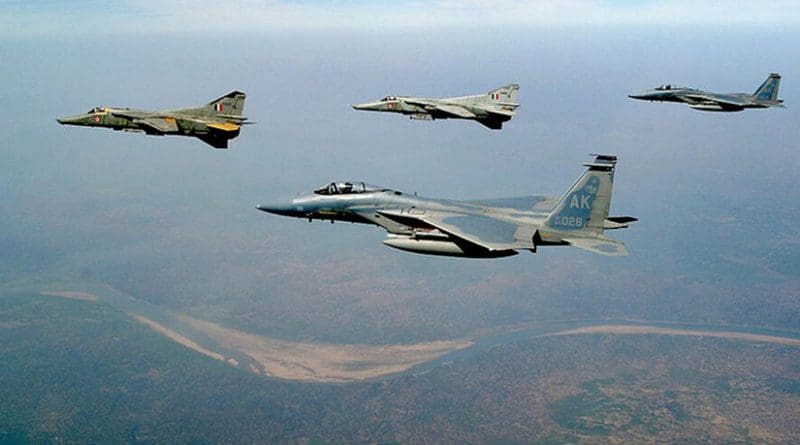Role Of Airpower And Enhanced Jointry In Indian Defence Forces – Analysis
By IPCS
By Murli Menon
The announcement by Defence Minister Manohar Parikkar in Goa that the government was about to clear the appointment of a Chief of Defence Staff (CDS) for the Indian armed forces is a very welcome one indeed. Besides this indicating a maturity in the polity regarding the viability and uncalled for insecurity surrounding this five star assignment, the CDS would also be a harbinger for transitioning the Army, Navy and the Air Force into a truly integrated defence force.
Needless to say, this the way to go given India’s unique threat spectra across widely dispersed frontiers on air, land and sea. India already has three single service and a joint doctrine in place. The IAF’s basic air power doctrine has an updated 2012 version, which incorporates the constituents of modern combat power and its several ‘combat enabling elements’. Also included in this compact 151-page seminal work are some unique aspects such as information warfare, aerospace, sub-conventional warfare, joint operations, nation-building, aerial diplomacy and perception management. The latest air power doctrine has also been declassified unlike its fore bearers in 1995 and 2007, the idea being to improve the understanding of aerial warfare aspects amongst all three services and indeed the discerning public at large.
India is well equipped to foster jointmanship considering that the major chunk of its officer cadre in all three services train together for three years, in their budding years, at Khadakvasala’s National Defence Academy. This fosters a natural penchant amongst officer comrades to understand the typicalities of each separate service, something which India can be justifiably proud of, being perhaps the only major power that has such a unique training establishment. It has always been disheartening for the professional or the veteran, therefore, to see age-old entrenched misgivings once again crop up amongst the three services occasionally, at various discussion fora and the media.
A recent editorial piece by an illustrious Army veteran talked of the need for the IAF to be given additional funds by the government so that dedicated Fighter Ground Attack aircraft such as the A-10/SU-34 and stand-off precision-guided munitions could be acquired. The author’s argument was that the Close Air Support mission was paramount to facilitate the Army’s tactical battle. Whilst it is condescending to advocate the Air Force’s wish list, it is indeed sad that the author does not understand the difference between a “balanced Air Force” (that the IAF aspires to be) rather than a “tactical Air Force,” which it has absolutely no inclination to be. This was precisely the reason why the Indian Air Force chose to articulate its first air power doctrine, much ahead of the articulation of the Army/Navy doctrine manuals. The worry is that much like the concerns during the earlier Air Force days, the senior Indian Army leadership appears to be still fixated on Close Air Support.
The first air power doctrine manual IAP 2000 understandably had a first chapter titled “the need for a doctrine”. It was meant to provide all air warriors with a “mission statement” and for everyone else dealing with the IAF, to understand the uniqueness of a nation’s air power. Suffice to state that air power, with its innate speed, reach, lethality, precision and flexibility, offers the government a cutting edge option to prosecute war. In any future integrated battle scenario, Indian military commanders have to understand the unique strengths and vulnerabilities of each combat arm. India cannot have premier service institutions (or its erstwhile leadership for that matter) articulate concepts in the national media displaying an utter lack of understanding of the intricacies of air aspects and air power. With the advent of the CDS and perhaps an integrated Ministry of Defence down the line, the day is not far off when senior military leadership would be called upon to testify on military matters in Parliament. Top-end professionalism and clarity on all elements of national power would be the order of the day.
National security demands two criteria for it to be viable. First, the government of the day has to be prepared in any contingency to use its military in the furtherance of national objectives. Second, and perhaps more importantly, the military itself needs to be honed and developed during peace time. As they say, “The more you sweat in peace, the less you bleed in war.” In this context, all practitioners of the operational art need to recognise that good joint military operations would revolve around interoperability amongst constituent forces and an atmosphere sans dogmatic approaches to war-fighting.
A democratic polity such as India’s could well be tempted to adopt a defensive approach to waging war. Especially in today’s terror threat scenarios involving non-state actors, air power offers the policy makers uniquely viable options. It has to be in the forefront of a nation’s options in the counter-terror campaign, as has been amply demonstrated recently in Yemen, Syria, Iraq and of course in Sri Lanka a while earlier. The leaders, military and civilian, need to be reminded that all air campaigns, combat and combat support, are important for the country. Air power is capable of going it alone, leading or following as the country’s air war strategy dictates.


Re author’s comment on a leading military commentator’s view: ” (tactical Air Force) which it [the IAF] has absolutely no inclination to be.”
Is it the author’s contention that a nation has to accept whatever “inclinations” towards fantasy roles one of its military services conjures-up for itself?
But I agree Government is being unnecessarily churlish: It should gladly furnish urgently the IAF with whatever it is “inclined to” for a dedicated squadron of replacements for the ageing Surya Kirans that so thrill the children thronging New Delhi’s Rajpath on Republic Day.